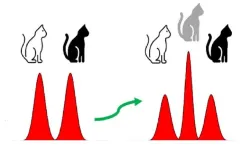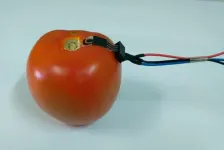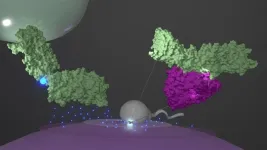(Press-News.org) The aim of this clinical trial, which has just received approval in France, is to assess the safety and efficacy of a new gene therapy drug in children aged between 6 and 31 months with profound hearing loss. Audiogene was developed by a French consortium composed of teams from the Hearing Institute, an Institut Pasteur research center; the ENT Department and Pediatric Audiology Research Center at Necker-Enfants Malades Hospital (AP-HP); Sensorion and Fondation Pour l'Audition. The trial has also been submitted to other European countries and is currently undergoing assessment.
Audiogene is the first clinical trial in France to test a gene therapy drug, SENS-501, developed by the biotech company Sensorion, to treat children with DFNB9, a form of hereditary deafness caused by mutations in the OTOF gene, which encodes a protein called otoferlin. The usual treatment for this form of hearing loss is a bilateral cochlear implant.
The aim of this treatment is to restore hearing. It works by injecting a copy of the normal otoferlin gene into the child's impaired inner ear. The SENS-501 drug is designed to correct the genetic abnormality in the inner ear cells of children with hearing loss and restore inner ear cell function and hearing in these children.
The first step in the clinical trial will be to test two doses of SENS-501 so that the optimal dose can be selected for the rest of the trial.
In practice, the SENS-501 gene therapy drug will be directly injected into the inner ear of the child with DFNB9 deafness. The drug is injected into the round window in the inner ear, in a similar way to cochlear implantation surgery. The procedure will be performed under general anesthetic by a lead ENT surgeon. The drug will be administered using an injection system developed in partnership with the company EVEON, so that the injected dose can be measured precisely and the inner ear structures can be preserved.
This gene therapy for hearing loss patients with an otoferlin deficiency was developed as part of the RHU AUDINNOVE project, involving a consortium composed of scientists from the Hearing Institute, an Institut Pasteur research center; physicians from the ENT Department and Pediatric Audiology Research Center at Necker-Enfants Malades Hospital (AP-HP); and teams from Sensorion and Fondation Pour l'Audition.
A collective effort that thrills the AUDINNOVE stakeholders
Denis Le Squer, Executive Director of Fondation Pour l'Audition, said: "The launch of the Audiogene clinical trial is a major step forward for deaf children with otoferlin defects and their parents but also brings hope to people with genetic deafness. We are very proud that our long-time support to French innovation and to the teams of Prof. Petit at the Hearing Institute, an Institut Pasteur research center, and Prof. Loundon, at the Clinical Center for Research in Pediatric Audiology at AP-HP Necker hospital, translates now into a trial."
Alain Chédotal, Chair of the Scientific Committee at Fondation Pour l'Audition: "The launch of the first gene therapy clinical trial for a deafness in France is a major milestone for Fondation Pour l'Audition, which supported the project from its beginning. It embodies our high-level scientific and medical actions and positions France as a key player in this field at an international level. It also embraces our strong ambition to speed up the development of therapies for individuals with hearing disorders."
Nawal Ouzren, Chief Executive Officer of Sensorion, said: "The launch of the Audiogene clinical trial is a significant milestone in the development program of SENS-501, a pioneering drug candidate in the field of gene therapies for genetic hearing loss. We are delighted to be continuing our collaboration with the team at the Fondation Pour l'Audition, the research teams at the Hearing Institute and the clinical team at the Pediatric Audiology Research Center at Necker-Enfants Malades Hospital (AP-HP), as part of the AUDINNOVE consortium. This consortium, composed of leading stakeholders, is currently one of the few players worldwide capable of bringing about a technological and medical revolution that offers real hope for all children with congenital hearing loss."
Natalie Loundon, Director of the Pediatric Audiology Research Center and a Pediatric Otolaryngologist and Head and Neck Surgeon at Necker-Enfants Malades Hospital (AP-HP), who is the Audiogene clinical trial coordinator investigator, comments: "This project is incredibly innovative and represents a first in the field, raising high hopes for patients with hearing loss. The project heralds the advent of a revolution in the future treatment of hearing loss patients. For this study, DFNB9 patients will be offered an alternative to cochlear implantation. We are already working on widening the indications to include other causes of hearing loss."
Christine Petit, Professor at the Institut Pasteur and Professor Emeritus at the Collège de France, added: "This clinical trial, which aims to correct the deficiency in a gene responsible for congenital hearing loss to restore hearing, is based on the pioneering research carried out at the Institut Pasteur in our Genetics and Physiology of Hearing Unit, which involved identifying the genes responsible, elucidating the defective mechanisms and demonstrating the possible reversal of hearing loss in the laboratory. We have been performing research on DFNB9 deafness for around 20 years now. Audiogene assembles a wide range of expertise so that these discoveries can be applied for the benefit of people with hearing loss. There is currently no treatment for hearing loss. The success of this clinical trial should serve as a catalyst in the search for much-needed therapeutic solutions for a whole series of hearing impairments and vestibular disorders."
Anne-Lise Giraud, Director of the Hearing Institute, an Institut Pasteur center, concluded: "The Hearing Institute is delighted with this major first, to which its teams, especially those led by Christine Petit and Saaid Safieddine, have made a huge contribution by paving the way for the translation of basic research into therapeutic applications."
Multiple technological innovations
A gene can only enter inner ear cells if it is transported by a viral vector that is capable of crossing the cell membrane. In this case the adeno-associated virus (AAV) is used to deliver the gene. As the OTOF gene is so big, it is divided into two DNA fragments, each transported by an AAV, which are then assembled inside the inner ear cells. This is referred to as a dual AAV vector technology. AAV vectors are harmless and non-pathogenic; they are reliable, well known and do not cause diseases. They are produced using the highest applicable industry standards and approved by health authorities for use in humans. Some are already in use and have been marketed as treatments.
This work was supported by the French National Research Agency which is funding the France 2030 program entitled RHU AUDINNOVE, ANR-18-RHUS-0007.
END
Audiogene, the first clinical trial in France for a gene therapy to treat hearing loss in children
2024-02-02
ELSE PRESS RELEASES FROM THIS DATE:
Vaccine targeting KRAS in pancreatic and colorectal cancer shows promise
2024-02-02
A new vaccine shows encouraging early results as a potential off-the-shelf treatment for certain patients with pancreatic or colorectal cancer, according to a study co-led by researchers at Memorial Sloan Kettering Cancer Center (MSK). The vaccine targets tumors with mutations (or changes) in the KRAS gene, a driving force in many cancers.
This cancer vaccine is different from another type of pancreatic cancer vaccine, which is custom-made for each patient using messenger RNA (mRNA). Both are therapeutic vaccines given after surgery ...
A physical qubit with built-in error correction
2024-02-02
There has been significant progress in the field of quantum computing. Big global players, such as Google and IBM, are already offering cloud-based quantum computing services. However, quantum computers cannot yet help with problems that occur when standard computers reach the limits of their capacities because the availability of qubits or quantum bits, i.e., the basic units of quantum information, is still insufficient. One of the reasons for this is that bare qubits are not of immediate use for running a quantum algorithm. While the binary bits of customary computers store information in the form of fixed values of either 0 or 1, qubits can represent 0 and ...
Biodegradable sensor monitors levels of pesticides via direct contact with surface of fruit and vegetables
2024-02-02
Researchers at the University of São Paulo (USP) and the Federal University of Viçosa (UFV) in Brazil have developed a sustainable sensor that can be placed directly on the surface of a vegetable or fruit to detect the presence of pesticides. Known for this reason as “plant-wearable”, it is made of cellulose acetate, a material derived from wood pulp.
The device has the potential to help assure food safety in a world that increasingly suffers from a shortage of food and the environmental and health problems caused ...
Paper: Multistate foodborne illness outbreaks impact restaurant stock price, public perception
2024-02-02
CHAMPAIGN, Ill. — As demand for food from restaurants soars in the U.S., so does the importance in understanding the impacts of foodborne illness outbreaks. A new paper co-written by a University of Illinois Urbana-Champaign expert in food marketing and food policy finds that outbreaks spanning multiple states bring swift financial losses, increased media attention and a public-relations hit that makes smaller outbreaks more financially damaging.
In the U.S., more than 60% of foodborne illness outbreaks occur at restaurants, and the vast majority of those outbreaks are confined ...
Identifying genomics markers to predict radiation sensitivity
2024-02-02
As the effectiveness of radiotherapy varies greatly between tumours, finding gene signatures to predict the radiation response could better guide the clinicians to personalize treatment plans. Professor Venkata Manem, affiliated with the Faculty of Medicine at Université Laval and the Centre de recherche CHU de Québec - Université Laval, has made a promising step to advance pre-clinical research in the field of precision radiation oncology.
Currently, doctors use a “one-size-fits-all” paradigm for radiotherapy, with a given dose and frequency ...
Turban style and thickness affects head injury risk in Sikh cyclists
2024-02-02
Sudden impacts or jolts to the head can cause skull fractures and traumatic brain injuries (TBIs). TBIs can cause bleeding, unconsciousness, and potential changes to the brain leading to memory loss, mood and personality changes and lack of concentration - sometimes many years after the initial injury.
However, very little research has been done to ascertain the extent and mechanism by which turbans might mitigate impacts to the head during cycling incidents.
Now, researchers from Imperial and the Sikh Scientists Network have studied the performance of turban styles ...
Scientists successfully simulate protein complex that initiates fertilization
2024-02-02
Who hasn't seen it before: the view through the microscope in which a sperm penetrates an egg cell and fertilises it. This fundamental step in procreation happens dynamically and seemingly without problems. However, if you zoom in on the processes that take place during fertilisation at a molecular level, it becomes highly complex and it is thus not surprising that 15 percent of couples worldwide struggle to conceive. No microscope, however modern, can illuminate the countless interactions between the proteins involved. Therefore, the exact trigger for the fertilisation process and the molecular events that transpire just before the fusion of the sperm and egg have ...
Immune cells lose ‘killer instinct’ in cancerous tumors – but functionality can be re-awakened
2024-02-02
Some immune cells in our bodies see their ‘killer instinct’ restricted after entering solid tumours, according to new research.
In a new paper published in Nature Communications, a team led by researchers from the University of Birmingham and the University of Cambridge found how immune cells called natural killer cells (NK cells) rapidly lose their functionality when entering and residing in tumours.
Using tumour cells grown from mice models, the team established that NK cells adopt a dormant state when entering solid tumours through the loss of production of key effector mechanisms used to promote immune ...
Did climate change trigger pandemics in antiquity?
2024-02-02
For their study in Science Advances, the researchers reconstructed temperatures and precipitation for the period from 200 BC to 600 AD, with a resolution of three years. This means that two data points cover a period of three years – an extremely high resolution for paleoclimate researchers. The period extends from the so-called Roman Climatic Optimum to the Late Antique Little Ice Age. This period also includes three major pandemics known from historians’ records: the Antonine Plague (around 165 to 180 AD), the Cyprian Plague (around 251 to 266) and the Justinian ...
Outstanding success in the Excellence Strategy: TU Dresden enters the next round with three new Clusters of Excellence initiatives
2024-02-02
As a result, TUD ranks second overall in the number of calls for proposals in the current competition nationwide. This is according to today’s joint announcement (February 2, 2024) by the German Research Foundation (DFG) and the German Science and Humanities Council (WR). An international panel of experts appointed by the DFG and the WR through the Joint Science Conference (GWK) has assessed a total of 143 draft proposals over the last few days and selected 41 as valuable funding opportunities.
In addition, TUD's three existing Clusters of Excellence have expressed their intent to the DFG that they wish to continue their outstanding research work. TUD, therefore, ...





